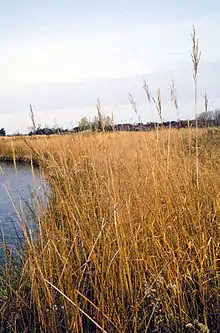| Sporobolus michauxianus | |
|---|---|
 | |
| Cordgrass along a pond edge | |
| Scientific classification | |
| Kingdom: | Plantae |
| Clade: | Tracheophytes |
| Clade: | Angiosperms |
| Clade: | Monocots |
| Clade: | Commelinids |
| Order: | Poales |
| Family: | Poaceae |
| Genus: | Sporobolus |
| Species: | S. michauxianus |
| Binomial name | |
| Sporobolus michauxianus (Hitchc.) P.M.Peterson & Saarela | |
| Synonyms | |
|
List
| |
Sporobolus michauxianus is a species of cordgrass known as prairie cordgrass,[1] freshwater cordgrass, tall marshgrass, and sloughgrass. It is native to much of North America, including central and eastern Canada and most of the contiguous United States except for the southwestern and southeastern regions. Its distribution extends into Mexico.[2] It is also present on other continents as an introduced species.[3]
Description
This species of grass has hard, sturdy, hollow stems that may reach 3 m (9.8 ft) in height.[4] They grow from a network of woody rhizomes and tough roots that form a sod. The roots penetrate over 3 m (9.8 ft) into the soil.[2] The leaves have sharp, serrated edges.[5] The panicle may be up to 50 cm (20 in) long and may have many branches. Each spikelet is up to 2.5 cm (0.98 in) in length.[3] This grass can spread via its rhizome, producing large monotypic stands.[2]
Habitat and ecology
This species can grow in a variety of habitat types, but it is a facultative wetland species, most often found in wet habitats. These include fens, wet prairies, rivers, floodplains, ponds, moraines, and marshes. The grass is tolerant of water, but it does not tolerate prolonged flooding. Its dense root network stabilizes soil, even in areas where it would be eroded by flowing water.[2]
The larvae of Photedes inops host on Sporobolus michauxianus, apparently exclusively.[6]
Uses
Livestock may graze on this plant when it is young, but once it matures it becomes very coarse and unpalatable.[2]
This species has been investigated as a possible source of biofuel.[7]
References
- ↑ USDA, NRCS (n.d.). "Spartina pectinata". The PLANTS Database (plants.usda.gov). Greensboro, North Carolina: National Plant Data Team. Retrieved 24 November 2015.
- 1 2 3 4 5 Walkup, C. J. (1991). "Spartina pectinata". Fire Effects Information System (FEIS). US Department of Agriculture (USDA), Forest Service (USFS), Rocky Mountain Research Station, Fire Sciences Laboratory.
- 1 2 Spartina pectinata. Grass Manual Treatment.
- ↑ Spartina pectinata. Washington Burke Museum.
- ↑ Spartina pectinata. USDA NRCS Plant Fact Sheet.
- ↑ "Comprehensive Report Species - Photedes inops".
- ↑ Goudarzi, S. Prairie Cordgrass for Ethanol Production. AIP Journal of Renewable and Sustainable Energy 21 November 2011.
